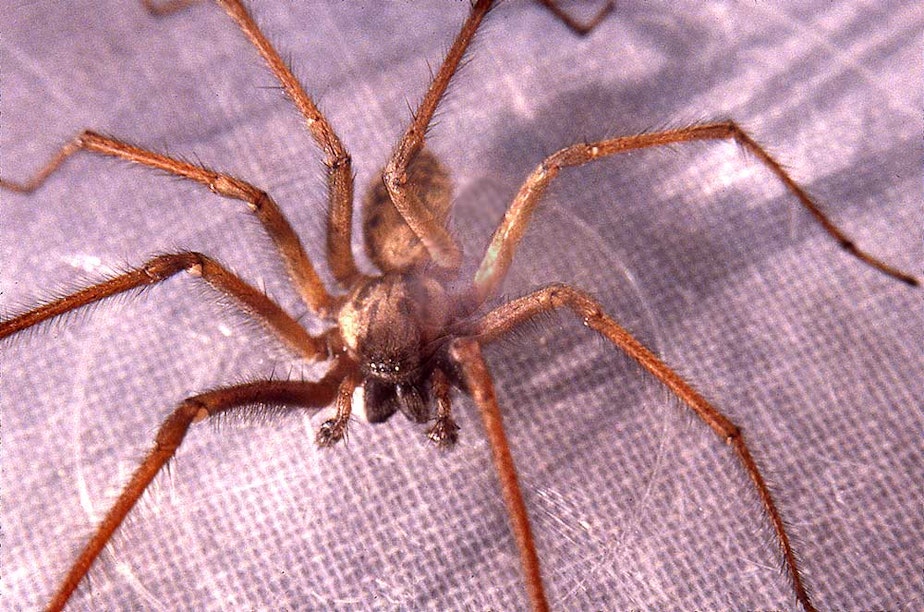Seattle's giant house spiders: Big and fast, but they won't kill you

Editor's note: This story references a spider found in Seattle homes that grows to be 4 inches across.
Certain spiders are so big, they make even the most spider-friendly humans leap off the couch, and those spiders, appropriately named “giant house spiders,” are on the move this time of year, looking for a mate.
You know the ones. They are quick and nimble. In fact, they can skitter across the living room floor at a speed of up to a half a meter per second. (Wicked fast for a spider, but slow for a human — 1.2 miles per hour.)
Also, they typically react to your freak-out by freaking out themselves, zipping under a spot where you don’t want to come upon them later, like under a slipper, or even worse, your bed.
Then the issue becomes what to do and who has to do it?
Is the plan to kill it? The problem with that plan is that giant house spiders eat other things that you typically don’t want in your home, explains Rod Crawford, who has studied, collected, and curated spiders at the Burke Museum in Seattle for 50 years.
“Spiders have to eat, and what they eat is household insects, and household insects can actually do various kinds of harm,” Crawford said. “Fleas, bedbugs, carpet beetles, clothes’ moths, cockroaches, a dozen stored food product pests, houseflies, mosquitos.”
Crawford's way of answering questions about spiders can be unsettling, depending on your predisposition to arachnids, which Crawford is quick to point out is not just a fancy name for spiders, but also includes other air-breathing anthropods with eight legs, such as scorpions, ticks, and mites… and wait, what’s that on your neck?
Maybe it’s just that after decades of answering the same knee-jerk questions about spiders, Crawford has grown cynical about the learning capacity of humans.
Or as he likes to put it, “Apes will be apes.”
(To be clear: We are the apes.)
Over the course of his 50 years at the Burke, Crawford has given approximately 250 lectures and classroom visits. For people who remain dubious about the value of spiders, he points them to his website, which is devoted to dispelling a plethora of Araneae myths and misinformation, under the headline, “Everything that ‘everybody knows’ about spiders is wrong!”
For example, what we commonly refer to as “daddy-longlegs” are, in most cases, not really spiders. Or that spiders come indoors in fall. There are actually indoor spiders and outdoor spiders, which are completely different species.
Another myth that will be hardly comforting to most people — spiders are actually not more numerous in late summer. Crawford clarifies that this perception is based on a few species, like larger orb-weavers and the giant house spider, that mature at this time.
This is also a time of year when Crawford is inundated with interview requests from ill-informed reporters who ask annoying questions like, “How did you get interested in spiders?” or, “Do you have a favorite spider?”
“That’s kind of a desperation question when you can’t think of anything sensible to ask,” he said.
So, let’s say you’re convinced at this point to not kill the hairy eight-legged creature that is now hiding under your slipper or bed.
If you’re both brave and deft, you might capture it under a container and carefully slide an envelope under to secure the agitated arachnid. But then what?
“If you take a house spider outside, you’re just condemning it to a slower and more lingering death,” Crawford said.
The best bet is to put captured spiders in another manmade structure, like a garage, crawlspace, toolshed, or carport.
Want to rid yourself forever of indoor spiders? Good luck with that.
Crawford says the best we can do is seal all cracks, caulk every crevice, weather-strip every door. And that’s just to limit spiders to the crawl spaces, floor voids, wall voids — what Crawford refers to as “their part of the building.”
“There’s nothing you can do about having spiders in your building,” he said. “They’ll be there no matter what.”
So we are doomed to live with spiders, or happy to cohabitate, depending on your perspective.
On a lighter note, only one of the 972 (and counting) types of spiders Crawford has helped to document in Washington state are dangerous to humans. While he is quick to point out that, unlike snakes, all spiders have venom, only the western black widow, which is limited to the Columbia Basin and a few islands, has venom that is dangerous to humans.
Which leads to what Crawford believes is the most dangerous myth about spiders — the belief that every bump, sore, and lesion people wake up and discover is a spider bite.
He notes that those bumps and sores should be examined by a doctor because it is much more likely that they are not spider bites and could be something much more dangerous and potentially life-threatening.
“Consider the life experience of a guy who has deliberately handled tens of thousand of spiders without wearing gloves or anything, and over a career of 50 years has gotten three genuine bites,” Crawford said.
So, what is Crawford’s advice the next time you are startled out of a near hypnotic state by an eight-legged creature scuttling across the floor inches from your feet?
“Just wave as they go by,” he said.


